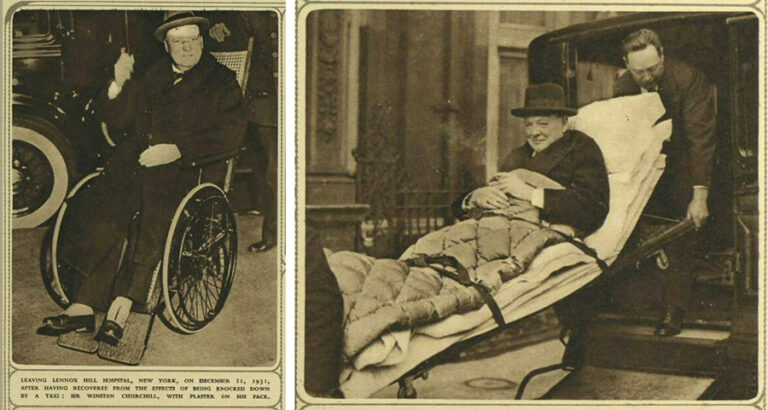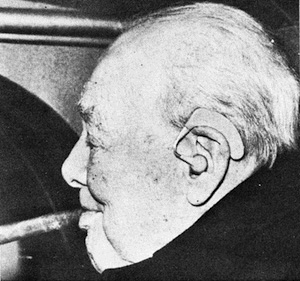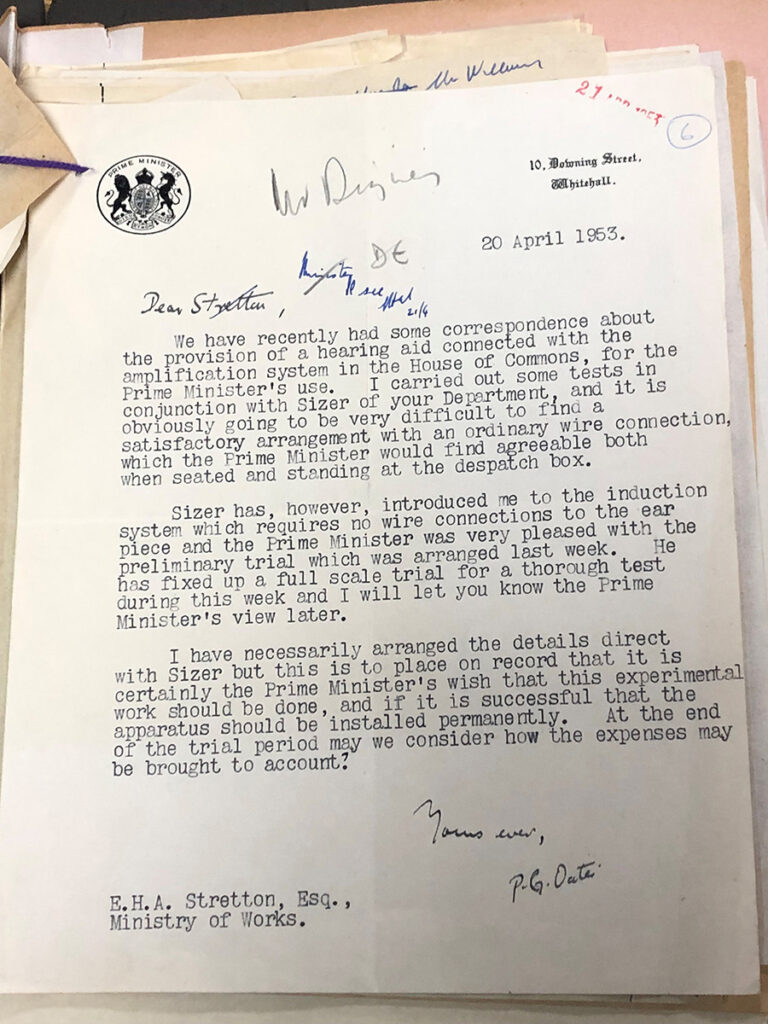Winston Churchill is best known for serving as British Prime Minister from 1940 to 1945, and between 1951 and 1955, as well as leading Britain through its ‘Darkest Hour’ during the Second World War.
Churchill experienced ill health throughout his life; he caught pneumonia multiple times, sustained injuries from a traffic accident, contracted paratyphoid, and suffered numerous strokes to name just a few examples.

The image on the left shows Churchill leaving Lennox Hill Hospital in New York after he was knocked down by a taxi in 1931. Pictured on the right is Churchill leaving Beaumont Street Nursing Home after an attack of paratyphoid in 1932.
As Churchill got older, he began to suffer from hearing loss, which is the focus of this blog. Records in the Ministry of Works reveal the various equipment that was installed in the House of Commons chamber during Churchill’s second term as Prime Minister to assist with his hearing.
Although these records do at times suggest how Churchill personally felt about the hearing equipment, it must be acknowledged that such opinions are not expressed directly from him, but rather through the Prime Minister’s Office. Moreover, the records do not express how Churchill felt about his hearing loss more broadly.
Nonetheless, these records provide a fascinating insight into how Churchill managed his hearing loss, and the ways in which the Ministry of Works utilised advances in technology to provide facilities to assist Churchill during his time in the House of Commons.
Churchill’s first hearing aid

Initially, Churchill was reluctant to admit that his hearing was deteriorating. His primary doctor, Sir Charles Wilson (also known as Lord Moran), first recorded Churchill’s hearing loss in late 1944. However, it was not until 1952 that Churchill had his first hearing aid fitted. (It must be noted that it was usual to only have one hearing aid, rather than two, which is the norm today).
The hearing aid was made by a company owned by Russian engineer Alexander Poliakoff. In order to ensure the device was working correctly, Poliakoff visited Churchill at 10 Downing Street. However in 1953, Poliakoff’s contract was ended. MI5 was concerned that Soviet Russia could bug the Prime Minister’s hearing aid to listen in on his conversations, although there is no evidence to suggest this was true (see footnote 1).
Provisions made in the House of Commons
On 20 April 1953, a letter from the Prime Minister’s Office to the Ministry of Works noted that arrangements were being made for ‘the provision of a hearing aid [for Churchill] connected with the amplification system in the House of Commons’ (footnote 2). It was also stated that the induction system would require ‘no wire connection to the ear piece’ and that ‘the Prime Minister was very pleased with the preliminary trial which was arranged last week’. The letter ended by saying that if the experimental work was successful, then the Prime Minister wished for it to ‘be installed permanently’ (footnote 3).

A memorandum produced by N Sizer, Assistant Chief Engineer on the project, explained how the equipment worked:
‘The system consists of an “inductive loop” round the Prime Minister’s seat near the Box and is hidden under the carpet. This inductive loop is fed from the Main Equipment via a special amplifier … This loop gives a magnetic field in the area within the loop, and the signal is picked up by a cylindrical piece of apparatus with leads connected to a moulded crystal ear piece. Thus perfect freedom of movement is possible for the Prime Minister as the instrument is completely on his person.’
Memorandum titled ‘Prime Minister’s Hearing Aid House of Commons’, produced by N. Sizer, 26 February 1954, WORK 11/606, The National Archives
This system works very much like a modern day hearing loop, which some readers may be familiar with. A hearing loop can be used by a hearing aid user in various settings, from a work meeting to a service counter at a bank. The hearing loop provides a magnetic wireless signal which is picked up by an individual’s hearing aid (when set to the correct setting) and amplifies the sound for the user.
As a result, the system in the House of Commons was able to pick up the sound of MPs speaking in the chamber. From here, it amplified this sound to Churchill’s hearing aid.
After a trial period, it appears that Churchill was happy with the arrangement. A letter sent from the Prime Minister’s Office to the Ministry of Works declared that ‘We have now reached a stage when the Prime Minister has said that he is quite satisfied with the installation and apparatus he has been provided with’ (footnote 4).
This story was picked up by both the national and local press. The Cork Examiner declared that this was ‘the first time the new system had been tried in the House of Commons’ (footnote 5). Moreover, the Birmingham Gazette reported that Churchill had begun to wear a hearing aid in the House of Commons ‘which seemed to enable him to catch without any difficulty interjections from all parts of the House – and to respond to them with all his old alacrity’ (footnote 6).
As to be expected, the system took a bit of getting used to. Graham Cawthorne, the parliamentary correspondent for the Morecambe Guardian, recalled:
‘I remember the first time Sir Winston tried a hearing aid. He looked very self-conscious as he raised his left hand to his ear. He took it away after a few minutes and I realise now that he was testing whether the aid would pick up the main speaker’s voice without the smaller noises. The next day he used it without looking self-conscious at all.’
‘How he left 176 women speechless’, Morecambe Guardian, 25 January 1955, p.5
Churchill was soon using the equipment with ease. A comical remark made by the Illustrated London News suggests that Churchill occasionally used his hearing aid to his advantage. The article read:
‘He had only to enter the House for a ripple, a stir, to go round the public galleries. In his hands, even his hearing aid became a weapon. Many an opponent and many a bore has been effectively silenced by that characteristic Winstonian flourish with which he snapped it off, or pulverised by a loud voice saying to a Front Bench colleague: “Who is this fellow, and what is he saying?”’
‘Churchill – The Man’, Illustrated London News, 24 April 1954, p. 56
Stepping down as Prime Minister
In April 1955, Churchill stepped down as Prime Minister, but remained an MP until 1964. This meant that he could no longer use the hearing system, as it was installed underneath the Prime Minister’s seat.
Without the system, Churchill had trouble hearing MPs in the House of Commons. A letter dated 6 May 1958 noted ‘Sir Winston was finding it difficult to hear in his present seat in the House’. Consequently, it was ‘arranged for the special amplifier, which he had as a Prime Minister, to be fitted in the new place’ (footnote 7). This meant that the system was transferred to his new seat in the chamber, so he was able to benefit from the equipment once more.

These records offer an interesting insight into Churchill’s hearing loss and his experiences in Parliament during the latter part of his career. Moreover, they show the ways in which Parliament was able to adapt, installing equipment which would have a positive impact on Churchill’s time in the House of Commons.
Footnotes
- Robin Nelson, Stephen Poliakoff on Stage and Screen (London, 2014), p. 9
- Letter from P G Oates (Prime Minister’s Office) to E H A Stretton (Ministry of Works), 20 April 1953, WORK 11/606, The National Archives
- Letter from P G Oates (Prime Minister’s Office) to E H A Stretton (Ministry of Works) 20 April 1953, WORK 11/606, The National Archives
- Letter from P G Oates (Prime Minister’s Office) to J H S Burgess (Ministry of Works), 23 February 1954, WORK 11/606, The National Archives
- ‘Mr Churchill’s Hearing Aid’, Cork Examiner, 17 April 1953, WORK 11/606, The National Archives
- ‘Mr Churchill back in form’, Birmingham Daily Gazette, 22 April 1952, p. 1
- Letter to A Lennox-Boyd, 6 May 1958, WORK 11/606, The National Archives
Interesting! This was revolutionary at the time. How far we have come and how far we have yet to go regarding hearing loss.
I thought I knew a lot about Churchill , this is another fact in a very interesting man. thanks. Paul Puttifoot
I think you should send this to Hearing Dogs charity … good PR for a focus on the difficulty. Many venues are still a challenge for a hearing aid wearer. Those with good hearing are often unsympathetic. Some are downright rude. It ought to be a rule that all public buildings/venues are hearing-enabled.